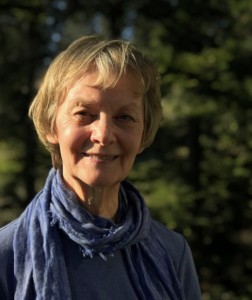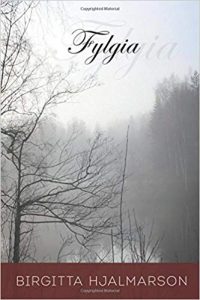We Are the Stories
 They named him Emir, after those powerful Arab rulers. He was an Ardennes draft horse, a roan gelding in a village in southwest Sweden. Why that name? His world was one of fog and snow, and summers so brief you hardly knew them, not one of palaces and sand dunes shimmering with heat.
They named him Emir, after those powerful Arab rulers. He was an Ardennes draft horse, a roan gelding in a village in southwest Sweden. Why that name? His world was one of fog and snow, and summers so brief you hardly knew them, not one of palaces and sand dunes shimmering with heat.
Barely a teenager, I watched my great uncle lead him back from the pasture. Lightning flared across the sky, the forest rose dense, and dark was coming on, even though it was still early. Emir stepped high at my great uncle’s side, eyes flashing white, hooves tossing up clods of grass and earth, as if something in the thunder called him.
My great grandfather kept shelves of studbooks in his farm office. The photographs showed Ardennes stallions measuring close to 17 hands, descendants of Belgian war and jousting horses, strong enough to carry knights in armor, yet agile and fast. He used one of them, Ballancourt, for his mares. When talking about him, he would emphasize the slope of his shoulders, just right to keep the collar in place, or the roundness of his croup, strong enough to pull the new agricultural machines, but what he really coveted, although loath to admit it, was the curve of his neck, the breadth of his forehead, and those dark, luminous eyes. Even when pairing him with a coarser mare, he hoped to possess at least a small part of that beauty. Perhaps he saw redemption in that, although all in all my great grandfather appeared to be a practical man.
Emir would stand motionless as I climbed on to his back. I used the milk tables as ladders. Every farm had them, wooden structures along the road, where the farmers left heavy milk cans for the dairy to collect. He stood motionless down by the inn, as the blacksmith fitted his shoes, the iron glowing red, the old men on the bench swapping stories as they rested their chins on their canes. But out in the stubble field, we practised dressage — figure eights, an extended trot on the diagonal, perfect walks and halts. Those who saw us from the country road must have shaken their heads. Dressage, of course, has its roots in war. Horses were trained to protect their riders, even to bite and kick. I suspect Emir viewed our exercises as just another task to perform, like tilling or ploughing, his patience as endless as the day. Yet, there were moments when his ambition stirred, and the push of his haunches made me grab his mane. When we failed at the half-passes, those tricky bends where we tried to travel sideways and forward both, he swished his tail.
I don’t know how long he lived. When I stopped coming to the farm, he was still young. In the end the Ferguson, the new tractor, surely won out. Even so, they would have kept him to haul logs out of the forest, where horses were more efficient, and machines tore down too much. By then I would have moved to America, leaving everything, even my memories, behind. Only now, after writing Fylgia, can I see him again, his winter coat curly with sweat, his fetlocks clumped with ice, his huge buttocks straining as he leans into the harness and pulls.
But as for that day, when his life finally ended, my vision blurs. I hope they gave him a long, gentle brush. Perhaps it was in the autumn, the air high and thin. His coat would have been gray rather than roan, and his back would have sunk, his withers more prominent now. I hope they combed his tail and ran a damp sponge across his forehead, the hollows above his eyes deep with age. When they picked his hoofs, they had to work fast, for he would have lacked the strength to hold them up for long. As they led him out to the truck, his shoes would have clipped the cobblestones and the stable cats would have crouched and fled. And as the sun strikes his eyes, still blinding but lacking in warmth, I see him raising his head and pointing his ears, his nostrils quivering at the scent of the desert wind.
—
Birgitta Hjalmarson studied Swedish, English, and German Literature at the University of Lund, Sweden. While covering the San Francisco art beat as a contributing editor for Art & Auction in New York, she also wrote Artful Players, a book on early California art. In Fylgia, her new novel, she returns to the village of her Swedish past.
Website: www.birgittahjalmarson.net
Twitter: twitter.com/birghjalmarson
Facebook: www.facebook.com/BirgHjalmarsonAuthor
Fylgia (July, Bedazzled Ink):
 The First World War rages on the continent. Hidden in the forest of Sweden, a country church gleams in the sun. Anna, a young woman, sits in the front pew. The vicar pauses to wipe his brow. “Think what harm will come to your children if your marriages begin in sin.”
The First World War rages on the continent. Hidden in the forest of Sweden, a country church gleams in the sun. Anna, a young woman, sits in the front pew. The vicar pauses to wipe his brow. “Think what harm will come to your children if your marriages begin in sin.”
Sixty years later, Anna gives refuge to a young niece, whose marriage is falling apart. Fredrik is long since dead. She still blames him for the death of their child, yet she misses his scent that would linger on her skin, like the moon that shone on the snow and colored it blue.
Each day she visits the child’s grave, an old woman in a tweed beret, her back no longer as straight. Time after time her thoughts return to the past, when she refused to accept the age-old beliefs the village stood for. Was she wrong to break the rules? How did she go on living when all seemed lost? How did she find her way when the map she followed was flawed?
Category: On Writing


























Eyes filled with tears, remembering childhood moments and a huge, warm horse to cling to. I see him right there in the small field, slowly moving around to grasp some grass. Marvellous to read and rediscover. Thank you, Birgitta!
What a beautiful post, Birgitta. Beautifully written, just like Flygia.